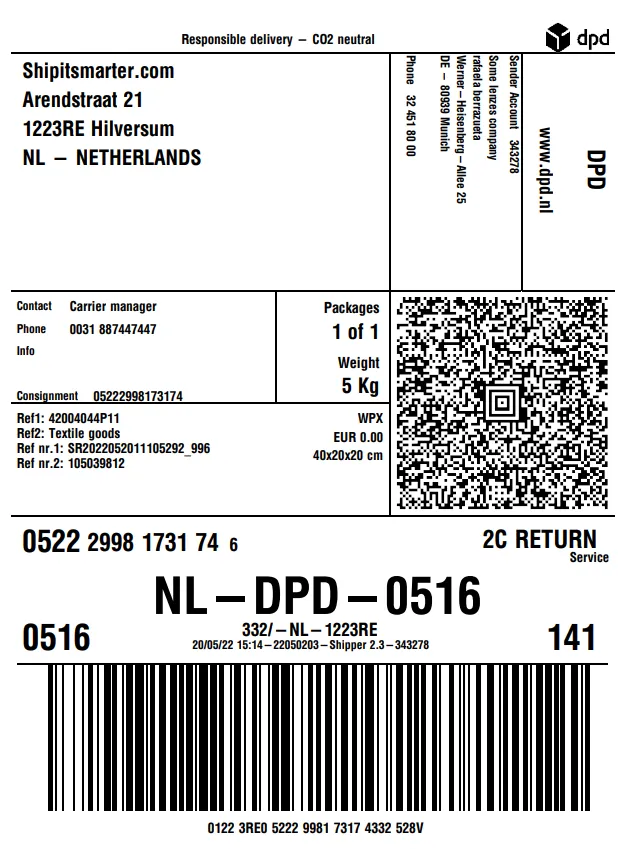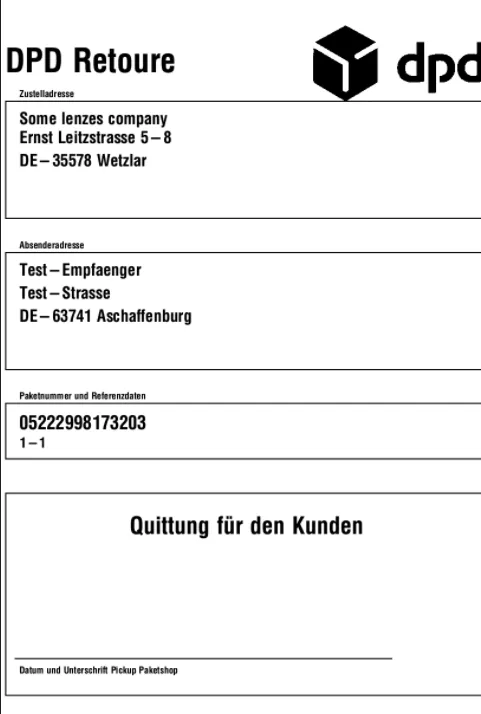DPD Netherlands ordering integration
The following is a guide to use Ordering integration from DPD Netherlands on the Viya platform.
Service levels
| DPD Code | DPD Description | Viya service level reference | Comments |
|---|---|---|---|
| IE2 | DPD EXPRESS | EXPRESS | |
| CL | DPD CLASSIC | CLASSIC or CLAPREDICT or CLASHOP | |
| B2C | DPD B2C | B2C or B2CPREDICT or B2CSHOP | |
| B2B | DPD B2B | B2B or B2BPREDICT | |
| E830 | DPD 08:30 | 0830 | |
| E10 | DPD 10:00 | 1000 | |
| E12 | DPD 12:00 | 1200 | |
| E18 | DPD 18:00 | 1800 or GUAR or GUARANTEE | GUAR orGUARANTEE will add a guaranteed flag to the message to DPD |
| PL | DPD PARCELLetter | LETTER | |
| PL+ | DPD PARCELLetterPlus | LETTERPLUS | |
| DPD International Mail | MAIL |
Servicelevels containing
PREDICTwill trigger thepredictoptions in the message to DPD
Servicelevels containingSHOPwill trigger theparcelshopoptions in the message to DPD
Dangerous Goods
The following dangerous goods types are supported by this integration:
- limitedQuantities
- lithiumBatteries
- exceptedQuantities
Predict
the DPD predict option will be triggered when using one of the following service levels:
CLAPREDICTB2CPREDICTB2BPREDICT
The predict option will request from DPD to inform the receiver through SMS or e-mail, as setup through the ordering configuration’s Predict channels to use option.
This option will only apply if the receiver’s phone number or e-mail address is provided in the order.
Parcel shop delivery
the DPD parcelshop option will be triggered when using one of the following service levels:
CLASHOPB2CSHOP
The parcelshop option will request from DPD to deliver the parcel to a DPD parcelshop. The parcelshop’s unique DPD ID may be provided through the drop off address’s carrierAssignedAddressId.
Similar to the predict option, the parcelshop option will also request from DPD to inform the receiver through SMS or e-mail, as setup through the ordering configuration’s Parcelshop channels to use option.
Shop Returns
A DPD ShopReturn be requested via a shipment (inbound=true) with service point (serviceOptions.returns.pickupPolicy =SERVICEPOINT)
This returns pickup label + signoff label. The customer then can dropoff the labelled parcel at a DPD service point.
The shopreturn is typically used to print a return label that is added inside the outbound parcel. The flow then would be:
sequenceDiagram participant Customer as Shipper participant SiS participant DPD
Customer-->>SiS: Outbound Shipment SiS-->>DPD: Parcel=true DPD-->>SiS: Outbound trackingRef + labels SiS-->>Customer: Outbound trackingRef + labels
Customer->>SiS: Shipment<br/>pickupPolicy=SERVICEPOINT SiS->>DPD: Parcel/Returns=true DPD->>SiS: Return labels SiS->>Customer: Return trackingRef + labels2 labels are returned:
- Label 1: Shipping label:
- Label 2: Return label
Collection (return) orders
A collection order can be created by setting the returns.isReturn flag to true in the shipment’s service options.
If the order is a collection request, the following will apply:
- The details in the
collectionaddress on the shipment will be shared with DPD as the collection address - The labels in the response will be default labels. The actual shipping labels will be printed by DPD, and attached by the DPD driver during the actual pickup.
Note, that a collection order cannot be combined with serviceOptions.returns.pickupPolicy servicePoint. If this is the case, the collection request will be ignored.
DPD’s definition of a “collection request”:
Collection request service represent an exchange between threeentities, where the Customer does not physically have the parcels tobe collected. This means that there is a Requester of the service itself,a Sender of a goods and a Receiver of a goods, where all threeentities can be placed in one country but also in three differentcountries
